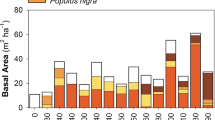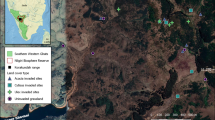Abstract
Background and aim
Exotic plant species can alter the nitrogen cycle in invaded ecosystems. We assess the differences in nitrogen use strategies and litter production and dynamics among three native riparian trees (Fraxinus angustifolia, Populus alba and Ulmus minor) and three co-occurring exotics (Ailanthus altissima, Robinia pseudoacacia and Ulmus pumila), currently spreading throughout river banks in inner Spain. We aim to predict the ecological consequences of a replacement of the natives by the exotics.
Methods
We compared the leaf lifespan, nitrogen resorption efficiency in leaves, nitrogen mean residence time, amount and timing of litter production and amount of nitrogen returned to soils between these native and exotic species.
Results
We found differences among species in all the variables measured, but not between native or exotic origins. Species were ranked from the most to the least conservative nitrogen use strategy as follows: U. pumila was the most conservative species, followed by the three natives (with an intermediate strategy), A. altissima and finally by the nitrogen-fixer R. pseudoacacia. The studied exotic species would produce contrasting impacts on the nitrogen cycle upon invasion.
Conclusions
On the basis of our results, we predict little impacts on the nitrogen cycle if U. pumila dominates the landscape. Despite being nitrogen-fixer R. pseudocacia would not increase soil nitrogen availability in the study area due to its low litter production and litter decomposition rates. In contrast, we predict an increase in nitrogen availability of soils upon A. altissima invasion, as this species produces a high amount of nitrogen rich and labile litter. This study offers a striking example of the contingencies involved in predicting the ecosystem impacts of exotic plant invasion.



Similar content being viewed by others
References
Adler PB, D’Antonio CM, Tunison JT (1998) Understory sucession following a dieback of Myrica faya in Hawai’i Volcanoes National Park. Pac Sci 52(1):69–78
Aerts R, Chapin FS (2000) The mineral nutrition of wild plants revisited: a re-evaluation of processes and patterns. Adv Ecol Res 30:1–67
Alonso A, González-Muñoz N, Castro-Díez P (2010) Comparison of leaf decomposition and macroinvertebrate colonization between exotic and native trees in a freshwater ecosystem. Ecol Res 25:647–653
Belote RT, Jones RH (2009) Tree leaf litter composition and nonnative earthworms influence plant invasion in experimental forest floor mesocosms. Biol Invasions 11:1045–1052
Boring LR, Swank WT (1984) The role of black locust (Robinia pseudoacacia) in forest sucesion. J Ecol 72(3):749–766
Bowman WD, Theodose TA, Schardt JC, Conant RT (1993) Constraints of nutrient availability on primary production in alpine tundra. Bull Ecol Soc Am 74:170–171
Carino DA, Daheler CC (2002) Can inconspicuous legumes facilitate alien grass invasions? Partridge peas and fountain grass in Hawai’i. Ecography 25(1):33–41
Castro-Díez P, González-Muñoz N, Alonso A, Gallardo A, Poorter L (2009) Effects of exotic invasive trees on nitrogen cycling: a case of study in Central Spain. Biol Invasions 11:1973–1986
Castro-Díez P, Fierro-Brunnenmeister N, González-Muñoz N, Gallardo A (2012) Effects of exotic and native tree leaf litter on soil properties of two contrasting sites in the Iberian Peninsula. Plant Soil 350:179–191
Cornelissen JHC, Pérez-Harguindeguy N, Díaz S, Grime JP, Marzano B, Cabido M, Vendramini F, Cerabolini B (1999) Leaf structure and defence control litter decomposition rate across species and life forms in regional floras on two continents. New Phytol 143(1):191–200
Dassonville N, Vanderhoeven S, Vanparys V, Hayez M, Gruber W, Meerts P (2008) Impacts of alien invasive plants on soil nutrients are correlated with initial site conditions in NW Europe. Oecologia 157:131–140
Eckstein RL, Karlsson PS, Weih M (1999) Leaf life span and nutrient resorption as determinants of plant nutrient conservation in Temperate-Artic regions. New Phytol 143(1):177–189
Ehrenfeld JG (2003) Effects of exotic plant invasions on soil nutrient cycling processes. Ecosystems 6(6):503–523
Ehrenfeld JG (2010) Ecosystem consequences of biological invasions. Annu Rev Ecol Evol Syst 41:59–80
Evans RD, Rimer R, Sperry L, Belnap J (2001) Exotic plant invasion alters nitrogen dynamics in an arid grassland. Ecol Appl 11(5):1301–1310
Gallardo A, Merino JM (1993) Leaf decomposition in two Mediterranean ecosystems of southwest Spain: influence of substrate quality. Ecology 74(1):152–161
Godoy O, Castro-Díez P, Van Logtestijn RSP, Cornelissen JHP, Valladares F (2010) Leaf traits of invasive species slow down decomposition compared to Spanish natives: a broad phylogenetic comparison. Oecologia 162:781–790
González E (2010) Contribution to the ecology of the Middle Ebro riparian woodlands: implications for management. Dissertation, University of Alcalá
Guerra A, Monturiol F (1970) Memoria explicativa del mapa provincial de suelos de Guadalajara. Escala 1:250.000. CSIC, Madrid
Haubensak KA, Parker IM (2004) Soil changes accompanying invasion of the exotic shrub Cytisus scoparius in glacial outwash prairies of western Washington (USA). Plant Ecol 175(1):71–79
Hughes RF, Denslow JS (2005) Invasion by a N2-fixing tree alters function and structure in wet lowland forest of Hawai’i. Ecol Appl 15(5):1615–1628
Kalmbacher R, Martin F (1996) Shifts in botanical composition of flatwoods range following fertilization. J Range Manage 49(6):530–534
Kourtev PS, Ehrenfeld JG, Haggblom M (2002) Exotic plant species alter the microbial community structure and function in the soil. Ecology 83(11):3152–3166
Lara F, Garillete R, Ramírez P (1996) Estudio de la vegetación de los ríos carpetanos de la cuenca del Jarama. Centro de Estudios y Experimentación de Obras Públicas. Ministerio de Fomento, Madrid
LeBauer DS, Treseder KK (2008) Nitrogen limitation of net primary productivity in terrestrial ecosystems is globally distributed. Ecology 89(2):371–379
Leishman MR, Haslehurst T, Ares A (2007) Leaf trait relationships of native and invasive plants: community and global-scale comparisons. New Phytol 176(3):635–643
Levine JM, Vilà M, D’Antonio CM, Dukes JS, Grigulis SL (2003) Mechanisms underlying the impacts of exotic plant invasions. Proc Biol Sci 270:775–781
Liao Ch, Yiqi L, Fang Ch, Chen J, Li B (2008) Litter pool sizes, decomposition, and nitrogen dynamics in Spartina alterniflora- invaded and native coastal marshlands of the Yangtze Estuary. Oecologia 156:589–600
Mack MC, D’Antonio CM, Ley RE (2001) Alteration of ecosystem nitrogen dynamics by exotic plants: a case of study of C4 grasses in Hawaii. Ecol Appl 11(5):1323–1335
Malcolm GM, Bush DS, Rice SK (2008) Soil nitrogen conditions approach preinvasion levels following restoration of nitrogen-fixing black locust (Robinia pseudoacacia) stands in a Pine-Oak ecosystem. Restor Ecol 16(1):70–78
Marchante E, Kjoller A, Struwe S, Freitas H (2008) Short- and long-term impacts of Acacia longifolia invasion on the belowground processes of a Mediterranean coastal dune ecosystem. Appl Soil Ecol 40:210–217
Marchante E, Kjoller A, Struwe S, Freitas HS (2009) Soil recovery after removal of the N2-fixing invasive Acacia longifolia: consequences for ecosystem restoration. Biol Invasions 11:813–823
Maron JL, Connors PG (1996) A native nitrogen-fixing species facilitates weed invasion. Oecologia 105(3):302–312
Matus G, Tóthmérész B, Papp M (2003) Restoration prospects of abandoned species-rich sandy grassland in Hungary. Appl Veg Sci 6(2):169–178
Milla R, Castro-Díez P, Maestro-Martínez M, Montserrat-Martí G (2005) Relationships between phenology and the remobilization of nitrogen, phosphorus and potassium in branches of eight Mediterranean evergreens. New Phytol 168:167–178
Montagnini F, Haines BL, Boring LR, Swank WT (1986) Nitrification potentials in early successional black locust and mixed hardwood forest in the southern Appalachians, USA. Biogeochemistry 2:197–210
Montagnini F, Haines B, Swank WT (1991) Soil solution chemistry in black locust, pine-hardwoods and oak-hickory forest stands in the southern Appalachians. Forest Ecol Manage 40:199–208
Monturiol F, Alcalá L (1990) Mapa de Asociaciones de suelos de la Comunidad de Madrid. Escala 1:200.000. CSIC y Comunidad de Madrid, Madrid
O’Neill RV, DeAngelis DL (1981) Comparative productivity and biomass relations of forest ecosystems. In: Reichle DE (ed) Dynamic properties of forest ecosystems. Cambridge University Press, Cambridge, pp 441–449
Paschke MW, McLendon T, Redente EF (2000) Nitrogen availability and old-field sucession in a shortgrass steppe. Ecosystems 3(2):144–158
Peloquin RL, Hiebert RD (1999) The effects of black locust (Robinia pseudoacacia L.) on species diversity and composition of black oak savannah/woodland communities. Nat Areas J 19:121–131
Rice SK, Westerman B, Federici R (2004) Impacts of the exotic, nitrogen-fixing black locust (Robinia pseudoacacia) on nitrogen cycling in a pine-oak ecosystem. Ecology 174(1):97–107
Sanz Elorza M, Dana Sánchez ED, Sobrino Vespertinas E (2004) Atlas de plantas alóctonas invasoras en España. Ministerio de Medio Ambiente, Madrid
Scott NA, Saggar S, McIntosh PD (2001) Biogeochemical impact of Heracium invasion in New Zealand’s grazed tussock grasslands: sustainability implications. Ecol Appl 11(5):1311–1322
Seabloom EW, Harpole WS, Reichman OJ, Tilman D (2003) Invasion, competitive dominance, and resource use by exotic and native California grassland species. Proc Natl Acad Sci USA 100(23):13384–13389
Simberloff D (2006) Invasional meltdown 6 years later: important phenomenon, unfortunate metaphor, or both? Ecol Lett 9(8):912–919
Simberloff D, Von Holle B (1999) Positive interactions of nonindigenous species: invasional meltdown? Biol Invasions 1:21–32
Soudzilovskaia NA, Onipchenko VG, Cornelissen JHC, Aerts R (2005) Biomass production, N:P ratio and nutrient limitation in a Caucasian alpine tundra plant community. J Veg Sci 16(4):399–406
Suding KN, Collins SL, Gough L, Clark C, Cleland EE, Gross KL, Milchunas DG, Pennings S (2005) Functional and abundance-based mechanisms explain diversity loss due to N fertilization. Proc Natl Acad Sci USA 102(12):4387–4392
Swan CM, Healey B (2008) The role of native riparian tree species in decomposition of invasive tree of heaven (Ailanthus altissima) leaf litter in an urban stream. Ecoscience 15(1):27–35
Tateno R, Tokuchi N, Yamanaka N, Du S, Otsuki K, Shimamura T, Xue Z, Wang S, Hou Q (2007) Comparison of litterfall production and leaf litter decomposition between an exotic black locust plantation and an indigenous oak forest near yan’an on the Loess Plateau, China. For Ecol Manag 241:84–90
Tuttle NC, Beard KH, Pitt WC (2009) Invasive litter, not an invasive insectivore, determines invertebrate communities in Hawaiian forests. Biol Invasions 11:845–855
Urgenson LS, Reichard SH, Halpern CB (2009) Community and ecosystem consequences of giant knotweed (Polygonum sachalinense) invasion into riparian forests of western Washington, USA. Biol Conserv 142:1536–1541
van Heerwaarden LM, Toet S, Aerts R (2003) Current measures of nutrient resorption efficiency lead to a substancial understimation of real resorption efficiency: facts and solutions. Oikos 101(3):664–669
Vanderhoeven S, Dassonville N, Meerts P (2005) Increased topsoil mineral nutrient concentrations under exotic invasive plants in Belgium. Plant Soil 275(1–2):169–179
Vilà M, Tessier M, Suehs CM, Brundu G, Carta L, Galanidis A, Lambdon P, Manca M, Médail F, Moragues E, Traveset A, Troumbis AY, Hulme PE (2006) Local and regional assessments of the impacts of plant invaders on vegetation structure and soil properties of Mediterranean islands. J Biogeogr 33:853–861
Vilà M, Espinar JL, Hejda M, Hulme PE, Jarosik V, Maron JL, Pergl J, Schaffner U, Sun Y, Pysek P (2011) Ecological impacts of invasive alien plants: a meta-analysis of their effects on species, communities and ecosystems. Ecol Lett 14(7):702–708
Zar JH (1999) Biostatistical analysis. Prentice Hall, Upper Saddle River
Acknowledgments
This study was supported by the projects CGL2007-61873/BOS, CGL2010-16388/BOS of the Spanish Ministry of Science and Innovation and POII10-0179-4700 of the Junta de Comunidades de Castilla-La Mancha. Noelia González-Muñoz was supported by a grant of the SMSI (FPI fellowship, BES-2008-002457) and by a grant of Alcalá University. We are grateful to the support of the REMEDINAL-2 network (Comunidad de Madrid). We acknowledge Rosendo Elvira and the staff of the Alcalá University Botanical Garden for their support to perform this experiment. We thank Natalia Fierro Brunnenmeister and Evelyn Beliën for her valuable help with the plant measurements. We are thankful to Melchor Maestro for conducting the cellulose analysis.
Author information
Authors and Affiliations
Corresponding author
Additional information
Responsible Editor: Harry Olde Venterink.
Rights and permissions
About this article
Cite this article
González-Muñoz, N., Castro-Díez, P. & Parker, I.M. Differences in nitrogen use strategies between native and exotic tree species: predicting impacts on invaded ecosystems. Plant Soil 363, 319–329 (2013). https://doi.org/10.1007/s11104-012-1329-x
Received:
Accepted:
Published:
Issue Date:
DOI: https://doi.org/10.1007/s11104-012-1329-x




